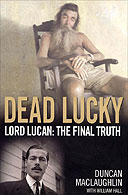
During 30 years of speculation, he has been "located" around the globe, from the jungles of Africa to the depths of the English Channel. But until now no one has placed Lord Lucan's hideout in Goa.
A new book published today claims that Richard John Bingham, the 7th Earl of Lucan, spent his final years there known as "Barry", a long-haired beachbum who ran jungle trips for visitors.
The co-authors, who include a retired Scotland Yard detective, say they have overwhelming evidence that Lucan did not commit suicide, as friends and family have maintained.
Instead, they say, he wound up on the westcoast of India where he drank, gambled and astonished the locals with his knowledge of vintage sports cars until his death in 1996.
"Lucky" Lucan, once a prominent society figure in Britain, has not been seen since November 7 1974, the day after Sandra Rivett, nanny to his three children, was found bludgeoned to death in the basement of a Belgravia house. Lucan's wife had raised the alarm at the nearby pub after she too had been attacked. His bloodstained car was parked on the coast at Newhaven.
The authors of "Dead Lucky" claim Lucan fled to Mozambique, and from there to Goa. His flight, they say, may have been arranged by the racing driver Graham Hill, a pilot and close friend.
Goa is now more famous for hedonists than fugitives, but in the mid-70s it was comparatively quiet.
It was not just Barry's expert knowledge of Bentleys and Bugattis that aroused suspicion, nor that he was a keen player of backgammon, one of Lucan's favourite games.
The timetable was right, too. Barry had arrived in Goa in 1975, not long after the murder, and claimed to have travelled via Africa.
Always reticent about his private life, he admitted to coming from Ireland, home to the Lucan estates, and, once asked about his knowledge of history, boasted: "I'm part of history."
Goanese also said British visitors would bring him wads of cash from time to time.
There was also a strong physical resemblance. Both men had distinctive arched, black eyebrows, for example, and neither had earlobes.
"Barry" was given a Viking-style cremation after his death, leaving no trace of DNA, but Duncan MacLaughlin, co-author and former detective believes that forensic analysis of photographs by Susan Black at Dundee University goes a long way towards proving his point. Prof Black, he said, was unable to disprove the connection.
"I went to India very sceptical," said Duncan MacLaughlin, co-author and former Metropolitan police detective. "But during my five weeks there I became convinced that, yes, this is him."
Fellow author William Hall said: "This book is about trying to establish beyond reasonable doubt that this was Lord Lucan. We are claiming we have overwhelming evidence."
But Lady Lucan rejects the claims, saying yesterday that she was "absolutely certain" the earl had killed himself.

